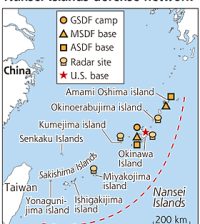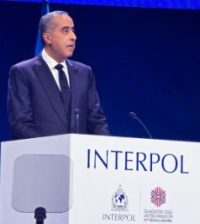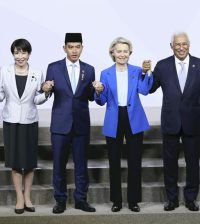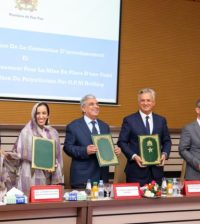- Washington “follows with interest” Morocco’s openness onto Africa (John Kerry)Posted 12 years ago
- The trial of South African Paralympic champion Oscar Pistorius opened in Pretoria on Monday.Posted 12 years ago
- USA welcomes efforts of King Mohammed VI in MaliPosted 12 years ago
- Egypt’s population reaches 94 millionPosted 12 years ago
- Mugabe celebrates his 90thPosted 12 years ago
- Moroccan Monarch to Build a Perinatal Clinic in BamakoPosted 12 years ago
- King Mohammed VI handed a donation of bovine semen for the benefit of Malian breeders.Posted 12 years ago
- Moroccan King’s strategic tour to Africa: Strengthening the will of pan African Solidarity and stimulating the south-south cooperation mechanisms over the continentPosted 13 years ago
- Senior al-Qaida leader killed in AlgeriaPosted 13 years ago
- Libya: The trial of former Prime Minister al-Baghdadi AliPosted 13 years ago
Takaichi and Trump to Meet in Tokyo: Security and Trade Dominate the Agenda
R. ELM. Tokyo 28 Oct: Japan’s newly appointed Prime Minister Sanae Takaichi and U.S. President Donald Trump will hold their first summit in Tokyo on Tuesday, with discussions expected to center on security cooperation and trade relations.
The meeting comes amid Washington’s calls for increased Japanese defense spending and expanded imports of American goods.
Strengthening the Alliance amid Regional Challenges
On the security front, both leaders are expected to reaffirm their commitment to reinforcing the Japan–U.S. alliance at a time of heightened tensions in East Asia. With China’s military assertiveness in the East and South China Seas and North Korea’s continued nuclear and missile development, the two countries aim to enhance their deterrence and response capabilities.
Takaichi, who assumed office just a week ago, is expected to emphasize her pledge—outlined in her inaugural policy speech—to raise Japan’s defense spending to 2 percent of GDP by March, accelerating the previous 2027 target by two years. The move aligns with Trump’s long-standing demand that U.S. allies take greater responsibility for their own defense budgets.
Japan has been steadily expanding its defense outlays since revising its National Security Strategy in late 2022. Takaichi has vowed to update this framework next year to reflect evolving regional and global security dynamics.
Continuity and Personal Diplomacy
A prominent conservative figure often described as a protégé of the late Prime Minister Shinzo Abe, Takaichi is known for her strong security stance and close alignment with Abe’s strategic vision. Trump, who enjoyed a notably cordial relationship with Abe during his first term, praised Takaichi ahead of his arrival in Tokyo, calling her “philosophically close” to the former leader.
The summit, held at Tokyo’s State Guest House, symbolizes continuity in the personal diplomacy that has underpinned Japan–U.S. relations in recent years. Both sides are expected to highlight their shared commitment to regional stability and freedom of navigation in the Indo-Pacific.
Economic Cooperation and Trade Commitments
Economic ties will also feature prominently in the talks. The two leaders are likely to review progress on a bilateral trade agreement signed in July, which includes Japan’s pledge to invest $550 billion in key U.S. sectors such as semiconductors, critical minerals, and shipbuilding, as well as to expand purchases of American agricultural and industrial products.
In exchange, the United States reduced tariffs on Japanese automobiles from 27.5 percent to 15 percent, a move welcomed by Tokyo as a sign of deepening economic cooperation.
The discussions will unfold against a backdrop of escalating U.S.–China rivalry, characterized by Washington’s tariff measures and Beijing’s control over strategic resources such as rare earth elements. Both governments are seeking to strengthen supply chain resilience and reduce economic dependence on China.
Defense Symbolism and Regional Outreach
Following the meeting, Takaichi and Trump are scheduled to travel by Marine One to the U.S. Navy base in Yokosuka, where they will board the aircraft carrier USS George Washington. The visit is expected to serve as a symbolic reaffirmation of the alliance’s military dimension.
Trump’s stop in Tokyo forms part of a three-nation Asian tour that began in Malaysia, where he attended meetings linked to the Association of Southeast Asian Nations (ASEAN). After his visit to Japan, he will head to South Korea, where a meeting with Chinese President Xi Jinping is reportedly planned for Thursday.
A New Chapter in an Enduring Partnership
As Takaichi seeks to consolidate her leadership and define her foreign policy direction, the Tokyo summit represents both a test and an opportunity. For Japan, it offers a platform to project strategic continuity and strengthen ties with its key ally. For Washington, it underscores the enduring importance of Japan as a cornerstone of U.S. Indo-Pacific strategy.
Amid shifting geopolitical realities, the meeting is expected to set the tone for a new phase in the Japan–U.S. partnership—one balancing security commitments, economic collaboration, and shared regional priorities. ( AB+Agencies)




